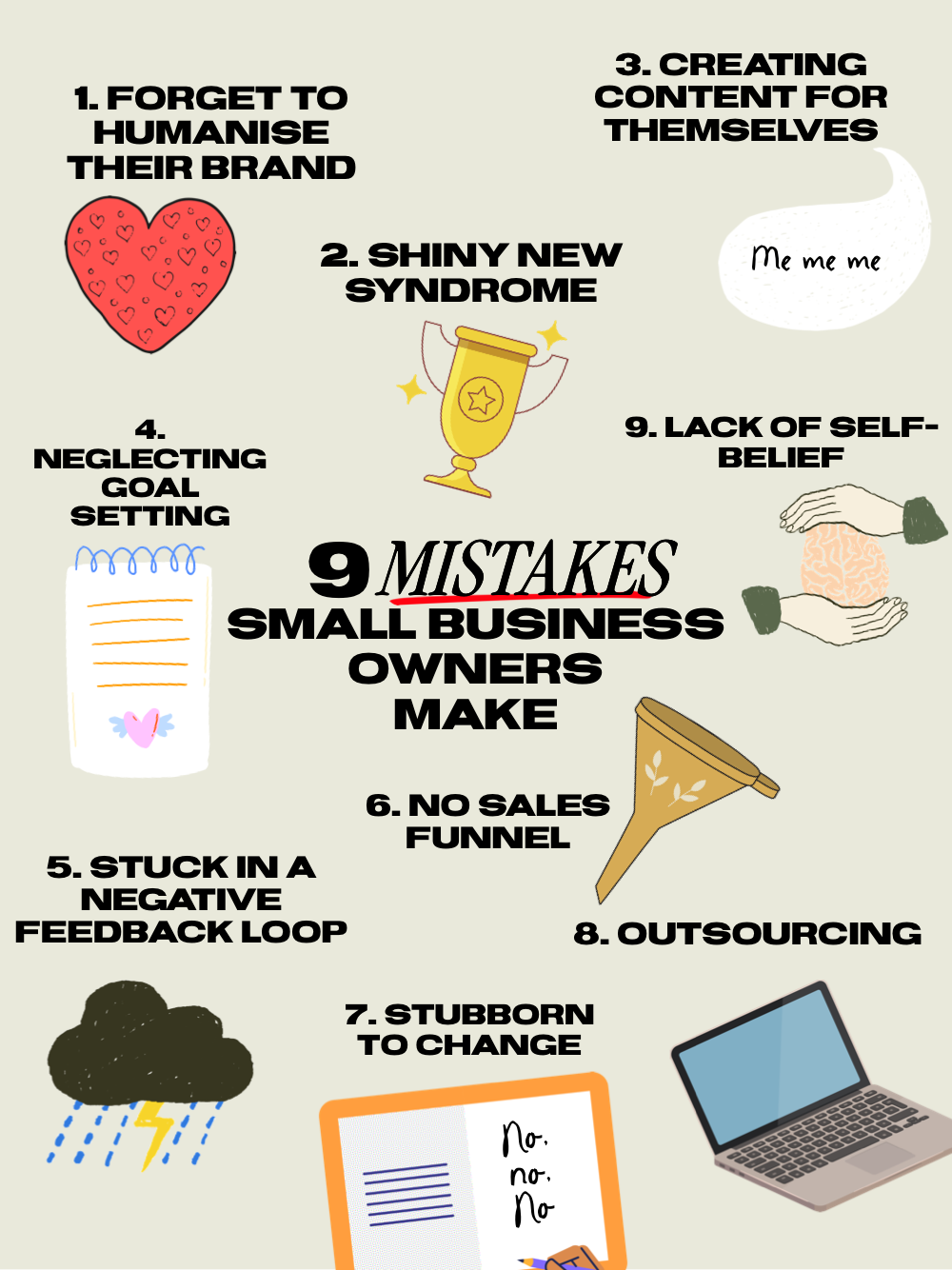10 common mistakes small business owners make that stunts growth..
- Forgetting to humanise their brand.
- Developing shiny new syndrome.
- Creating content for themselves not others.
- Neglecting goal setting.
- Getting stuck in a negative feedback loop.
- Not creating a sales funnel.
- Being Stubborn to change
- Lack of intelligence with outsourcing.
- Copying others in the industry.
- Lack of self-belief.

Running a small business is no easy feat. From managing day-to-day operations to strategizing for long-term growth, there's a lot on your plate. However, there are common pitfalls that can hinder your progress. Here are 10 mistakes small businesses often make that stop them from reaching their full potential, and how you can avoid them.
1. Small Business Mistake - Forgetting to Humanise Your Brand
People buy from people, not faceless entities. When you humanize your brand, you create a connection with your audience. Share your story, showcase your team, and engage with your customers on a personal level. Authenticity and relatability can significantly boost your brand loyalty and customer retention. Bigger brands like Nike are always trying to do this with influencer contracts - small business owners have the upper hand here.
How to Avoid This Mistake
Share Your Story : Use your website, social media, and marketing materials to tell the story of your business. Highlight your journey, mission, and values.
Showcase Your Team : Introduce your team members with photos and bios on your website and social media. This makes your business more relatable and trustworthy.
Engage Personally : Respond to comments and messages on social media, send personalized emails, and create content that speaks directly to your audience’s needs and interests.
2. Developing Shiny New Syndrome
It’s tempting to constantly release new products or services, but this can be detrimental if you haven’t mastered selling what you already have. Focus on perfecting your current offerings and building a robust marketing strategy before diversifying your product line. This ensures your resources are used efficiently and your existing products get the attention they deserve.
How to Avoid This Mistake
Analyze Performance : Regularly review the performance of your current products. Identify strengths, weaknesses, and opportunities for improvement.
Strengthen Marketing Efforts : Invest in marketing strategies that effectively promote your existing products. Utilize SEO, social media, email marketing, and paid ads to reach a broader audience.
Gather Customer Feedback : Listen to your customers’ feedback to refine your products and services. Use surveys, reviews, and direct communication to gather insights.
3. Creating Content for Themselves, Not Others
Content is king, but only if it resonates with your audience. Avoid creating content that interests only you. Instead, understand your customers' pain points, interests, and needs. Tailor your content to provide value to them, whether it’s through informative blog posts, engaging social media updates, or helpful how-to videos.
How to Avoid This Mistake
Know Your Audience : Conduct market research to understand your target audience’s demographics, interests, and pain points.
Create Value-Driven Content : Focus on creating content that educates, entertains, or solves problems for your audience. Use customer feedback and analytics to guide your content strategy.
Engage and Interact : Encourage interaction by asking questions, responding to comments, and creating content that invites discussion.
4. Neglecting Goal Setting
Without clear goals, your business lacks direction. Set specific, measurable, achievable, relevant, and time-bound (SMART) goals. Whether it’s increasing sales by 20% in the next quarter or launching a new product by the end of the year, goals give you something to strive for and a way to measure your progress.
How to Avoid This Mistake
Set SMART Goals : Define goals that are Specific, Measurable, Achievable, Relevant, and Time-bound. This ensures clarity and focus.
Break Down Goals : Divide large goals into smaller, manageable tasks. Create a timeline and assign responsibilities to ensure steady progress.
Track and Adjust : Regularly review your progress and make adjustments as needed. Use tools like KPIs, analytics, and regular check-ins to stay on track.

5. Getting Stuck in a Negative Feedback Loop
When your content flops or sales dip, it’s easy to get discouraged and stop trying. This creates a vicious cycle where inactivity leads to further decline. Break this loop by analyzing what went wrong, learning from your mistakes, and persistently trying new strategies. Consistency and adaptability are key to overcoming setbacks.
How to Avoid This Mistake
Analyze Failures : Instead of giving up, analyze what went wrong. Look for patterns, gather feedback, and identify areas for improvement.
Learn and Adapt : Use the insights gained from failures to adjust your strategies. Stay flexible and open to trying new approaches.
Stay Consistent : Maintain a regular posting and marketing schedule. Consistency builds momentum and keeps your audience engaged.
6. Not Creating a Full Sales Funnel
A well-defined sales funnel guides potential customers from awareness to purchase. Without it, you miss opportunities to nurture leads and convert them into buyers. Map out each stage of your funnel—from attracting leads to closing sales—and ensure you have strategies and tools in place to move prospects through each stage effectively.
How to Avoid This Mistake
Define Your Funnel Stages : Identify each stage of your sales funnel: awareness, interest, decision, and action. Tailor your strategies for each stage.
Create Content for Each Stage : Develop content that addresses the needs and concerns of prospects at each stage of the funnel. This can include blog posts, videos, case studies, and product demos.
Use Marketing Automation : Implement tools like email marketing automation to nurture leads through the funnel. Personalized emails and follow-ups can significantly improve conversion rates.
7. Being Stubborn to Change
The business landscape is constantly evolving, and what worked yesterday might not work today. If you’re unwilling to adapt, you risk becoming obsolete. Stay informed about industry trends, be open to feedback, and be willing to pivot your strategies when necessary. Flexibility can be a significant advantage in staying competitive.
How to Avoid This Mistake
Stay Informed : Keep up with industry news, trends, and best practices. Subscribe to relevant blogs, attend webinars, and join industry groups.
Be Open to Feedback : Listen to feedback from customers, employees, and peers. Use it constructively to make necessary changes.
Experiment and Innovate : Regularly test new ideas and strategies. Be willing to take calculated risks and pivot when needed.
8. Lack of Intelligence with Outsourcing
Outsourcing can be a double-edged sword. Outsource too much, and you waste resources; outsource too little, and you become overwhelmed. Identify tasks that are outside your core competencies and outsource them strategically. This allows you to focus on what you do best while still leveraging external expertise.
How to Avoid This Mistake
Identify Core Competencies : Determine which tasks are essential to your business and which can be outsourced. Focus on your strengths and delegate the rest.
Vet Outsourcing Partners : Choose outsourcing partners carefully. Look for expertise, reliability, and a track record of success.
- Monitor Performance : Regularly review the performance of outsourced tasks. Ensure they meet your standards and provide value for your investment.
9. Copying Others in the Industry
While it’s wise to keep an eye on your competitors, blindly copying them will always leave you a step behind. Instead, innovate and carve out your unique path. Understand your unique selling proposition (USP) and highlight what sets you apart from the competition. Originality will help you stand out in a crowded market.
How to Avoid This Mistake
Define Your USP : Clearly articulate what makes your business unique. Focus on your strengths and what you offer that competitors don’t.
Innovate Regularly : Encourage a culture of innovation within your business. Regularly brainstorm new ideas and improvements.
Stay True to Your Brand : Maintain consistency in your branding and messaging. Authenticity builds trust and loyalty among your customers.
10. Lack of Self-Belief and Persistence
Your mindset plays a crucial role in your business’s success. If you don’t believe in your potential for greatness, you’ll be less likely to take bold actions. Cultivate a positive mindset, stay persistent, and remind yourself of your past successes. Self-belief fuels perseverance, which is essential for overcoming challenges and achieving long-term growth.
How to Avoid This Mistake
Cultivate a Positive Mindset : Practice positive affirmations, visualize your success, and focus on your achievements.
Set Realistic Expectations : Understand that success takes time and setbacks are part of the journey. Stay patient and persistent.
Seek Support : Surround yourself with supportive people. Join entrepreneurial groups, find a mentor, or seek professional development opportunities.
By avoiding these common mistakes, your small business can thrive and grow. Humanize your brand, set clear goals, adapt to change, and believe in your potential. Remember, growth is a journey, not a destination. Stay committed, stay innovative, and watch your business flourish.
For more tips and resources on growing your small business, follow me on Instagram. Let's achieve greatness together!

